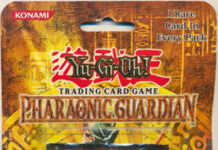If you do a Google search for “Goat Format Yugioh” or something along those lines, you’re going to find a plethora of articles, Reddit threads and YouTube videos dedicated to telling you about the format and why you should play it. I’m not going to try to compete with those considering that most are written by far better players than myself. You can visit Jazz’s Format Library, read Kris Perovic’s article on why you should play Goat Format, or even go to DuelistGroundz to read their Intro to Goat Control thread. There’s plenty to get you started.

But something that most of those articles don’t really discuss are the basics of actually approaching a Goat Format duel, which in my opinion is pretty important. While the format is widely regarded as the best test of skill, actually getting better is a lot easier said than done. That’s why I want to talk about some of the basics involved in winning in Goat Format.
Goat Format Basics – Before we Start
Netdeck. Seriously, freaking netdeck.
If you’re just starting in Goat Format, don’t build your own deck. You’ll likely get a warped view of how the format operates and you’ll set yourself back in your development as a Goat Format player. Instead, netdeck.
To be fair, some of the novelty of old-school Yu-Gi-Oh! lies in the fact that the card pool is small and nostalgic. Many people have tried to innovate the format since, but most all of those theories have already been tried and tested. As such, with the format streamlined by better players, a lot of the work has already been done for you. You get better by playing with and against the best, and you won’t get better if you’re building crappy decks and ignoring what the best players are saying and doing.
Leave modern theory at the door
There are some theories that were advanced after Goat Format that have warped the format since it was live in 2005. But for the most part modern Yu-Gi-Oh! theory has little place in Goat Format. Patient, methodical play wins more than big boards and huge combos. The modern game is little like Goat Format, so you have to leave a lot of what you think you know about Yu-Gi-Oh! behind when you start playing Goats.
Have the actual, physical cards and decks
Most of you reading this article have either played Goat Format or modern Yu-Gi-Oh!. If you’re completely new to the game of Yu-Gi-Oh!, Goat Format is definitely a great starting point. But this series really isn’t for you. You’ll learn a lot about Goat Format, don’t get me wrong, so definitely read it. But I’m assuming that most of you reading this are coming to Goat Format because you want something that isn’t modern, regardless of your level of skill. You’re intrigued and you want to learn more, and that’s awesome.
One of the best things you can do is to actually build the deck. Preferably two. And the reason why you should have the actual, physical cards and deck built is so that you can familiarize yourself with them. I suppose it’s possible to do this online, so it may just be preference. But I find that having the cards in my hand helps me better remember them, which in turns helps when I’m trying to theorize about the format or the deck or trying to pick apart my deck or my plays.
Goat Format Basics – Pre-Duel
Before you even start a game of Goat Format you have to understand how the deck wins. Standard Goat has a variety of plays that it can make during every stage of a duel. As such, its strength lies in its versatility, which is why it’s still be the best deck in a format that’s over twelve years old. Again, take some time and familiarize yourself with the deck so you can better understand what’s going on below.
Understanding the numbers
Something you have to understand is that Goat Format is all about the numbers. And I’m sure you modern players are going “well, yeah!” and that’s understandable because modern is also all about the numbers…but in a different way.
In Goat Format, even playing the Trinity on your opening turn will only net +3 in total card advantage…and if you don’t know how to calculate advantage, the formula is easy and you can read about it elsewhere. Regardless, there aren’t insane 20-card combos you have to memorize. Instead, you’re looking to gain advantage in numbers through getting the most value out of your cards.
This results in a “less is more” mentality, because each card has a certain value at different times. You want to maximize the value of every card you have while preventing your opponent from doing the same. Those incremental plusses tend to lead to more advantage in the mid-game, which usually translates to more wins. But then again, you can have ten cards and be plus five on your opponent and still lose the game, thanks to some sacky cards (Black Luster Soldier, for one). But that’s usually pretty rare. When you’re up on the numbers you have more options available to you, which increases your odds of winning.
Understanding card value
Card value refers to how valuable is a given card at any given point of a duel. Understanding card value theory is easy, but figuring out the value of each card in every situation is not. However, it’s a key tenet of playing well in Goat Format, so it’s something that you need to start paying attention to. The value of your cards will change almost on a turn-by-turn basis; a copy of Metamorphosis, for instance, may not be useful in the opening turns of a duel. But, a few turns down the road, that Metamorphosis could lead to a strong Thousand-Eyes Restrict summon at just the right moment.
Another example is Snatch Steal. It may be tempting to play it to kill something like a Spirit Reaper, but it might be better saved for when your opponent plays Airknight Parshath or Black Luster Soldier – Envoy of the Beginning. In this way card value is about more than just seizing opportunities; it’s also about patient and methodical play using the “less is more” strategy.
Know your power plays
If you asked a Goat Control player what the power plays of their deck are, most would start with the Thousand-Eyes Restrict lock. Some would include a Black Luster Soldier – Envoy of the Beginning drop, or perhaps looping pieces of the Trinity with Magician of Faith. Regardless, the deck has a lot of plays that are quite potent, but they’re not plays that you necessarily have to make just because you can.
Dropping a Thousand-Eyes Restrict to lock the board can be good if you have a Tsukuyomi in hand to reset it. Dropping Thousand-Eyes just because you can, though, is often a waste of a Metamorphosis. You have to not only know your power plays, but also when to use them and when not to use them. Sometimes the best plays are the plays you don’t make.
Likewise, dropping Black Luster Soldier because you can is something you can do, but it’s not always something that will win you the game. You need to determine when the best time to play your cards is – and that takes playing, practicing and thinking about everything you do in-game.
Cards are worth less if they’re on the field
There isn’t a hard or fast numerical way to determine card value, but a general rule is that cards in the hand are worth more than cards on the field. In the hand they are vulnerable to like three cards, only one of which sees any real play (Delinquent Duo). As such, maintaining a small field and a big hand tends to be a better strategy than the reverse. There are times where this isn’t the case, but on the whole, cards tend to be worth less on the field than in hand.
This is important because it will color what plays you make during any Goat Format match you play. There are cards you won’t want to play right away, and some that are better early as opposed to later in the match, and vice-versa.
It’s all about the why
The best players in Goat Format are really, really good at “reading” their opponent’s cards. This is tantamount to guessing, really, but sometimes it’s not hard to guess what an opponent’s doing. And the easiest way to suss that out is to figure out the why. Why did they do what they did? They used that card instead of this card; why? Couldn’t they have made that play later; if so, why make it then? Why were they aggressive, or passive, in their opening turns? Why did they grab that card with Magician of Faith? How might they use what they got off Merchant?
At this point I’m asking why my opponent did something every time they do something. And once you can start answering that question correctly more often than not, you’re going to make reads a lot more easily. This will lead directly to more wins for you because you’ll be able to read the plays your opponent is making as they make them and then counter it accordingly. We’ll get more into the why of everything in future articles, too.
Goat Format Basics – The Opening Turn
Many players believe that the opening turn is one of the most important of a game. While this is certainly debatable, how you open is pretty important, so it’s important to understand some of the better ways to open. There are some good guidelines about first-turn plays in Goat Format that I want to cover. Note I say guidelines, not rules – even the best players have gone counter to these at one point or another. But on the whole, this will help your first turn become more powerful. Note: there are a lot of potential first turn plays you can make in Goat Format, so this is hardly exhaustive.
Play based on the value of your hand
 This is one of the most important facets of a solid opening play, but also one of the hardest things to do properly. You have to gauge your plays based on what you have. The T-set is such a powerful opening because most anything else will tip a good player off. If you set a monster and two backrow, most will assume one is a Dust Tornado. Play a piece of the Trinity turn one and then set a monster, many will assume Magician of Faith. You set one backrow by itself, many people will assume Scapegoat or Ring or Destruction. If you set your entire hand, people will think Morphing Jar.
This is one of the most important facets of a solid opening play, but also one of the hardest things to do properly. You have to gauge your plays based on what you have. The T-set is such a powerful opening because most anything else will tip a good player off. If you set a monster and two backrow, most will assume one is a Dust Tornado. Play a piece of the Trinity turn one and then set a monster, many will assume Magician of Faith. You set one backrow by itself, many people will assume Scapegoat or Ring or Destruction. If you set your entire hand, people will think Morphing Jar.
Notice a recurring theme here? Good players continually are asking themselves why you’re doing what you’re doing and trying to react accordingly. And that by itself can lead to some pretty revealing information, as noted above. Some are better at it than others, of course, but you have to always assume that your opponent is good enough to figure out why you played what you did.
Note too that it’s not necessarily a bad thing. If you set a Scapegoat by itself and they call it out as Scapegoat they still have to play around it or work through your Goat tokens. You can play Pot of Greed and set a monster that isn’t Magician of Faith to try to bait out a Nobleman of Crossout to set up for a play later. That’s a perfect example of maximizing your card’s value, especially if you lose something irrelevant to Nobleman while protecting your Magician of Faith.
Don’t waste your cards
The biggest mistake I see newer players make is wasting cards. Whether they’re setting backrow they don’t need to set, or they’re setting a monster that doesn’t need to be set, or they’re summoning something “just because,” there are many ways that you can waste a first turn play.
If the only monster you draw is Tsukuyomi, why would you set it first turn? What does that net you? Sure, it stands up to low-ATK monsters (Mystic Tomato, Shining Angel, etc). But most of the time Tsukuyomi is better in your hand. In hand he can out your opponent’s Thousand-Eyes or loop your own. He can set up a Nobleman play on an opponent’s monster, or recycle Magician of Faith. He can do a lot…but not if he’s set for no reason.
If you look at your hand first turn and you don’t see any good plays to make, why try to force something? This comes back to card value – if your cards turn one don’t have a lot of value that turn, it doesn’t mean they aren’t valuable, it simply means they aren’t as valuable that turn. Every subsequent turn the value of those cards are going to change, but if you don’t use them at their maximum value, you’re essentially wasting your cards.
Cover your bases as best you can
 Most first-turn plays tend to be passive regardless of who you’re playing. Because players approach games of Goat Format with a “do more with less” mentality, big first turn boards are decidedly rare. As such, if you’re going first, you want to make sure you have a response to monsters that they summon, but you shouldn’t worry about them playing Graceful Charity to dump a LIGHT and a DARK and then having them drop Black Luster Soldier on you. That does happen, but in, like, one game in a hundred, if that.
Most first-turn plays tend to be passive regardless of who you’re playing. Because players approach games of Goat Format with a “do more with less” mentality, big first turn boards are decidedly rare. As such, if you’re going first, you want to make sure you have a response to monsters that they summon, but you shouldn’t worry about them playing Graceful Charity to dump a LIGHT and a DARK and then having them drop Black Luster Soldier on you. That does happen, but in, like, one game in a hundred, if that.
Most people going second will either mirror your T-set or look to break yours up. This is why you need to cover your bases. If your first-turn play is vulnerable to a Breaker the Magical Warrior, chances are it’s not a good play. See, you have to prepare for them to out your board, and to do so you have to think of all the ways they can do that, and then figure out which are likely and which are not. This is why you need to cover your bases.
Really, you always want to have a follow-up if they get rid of all the cards on your field. That’s what covering your bases means. If you have a followup to them breaking your board, you’re typically in a good spot. If you can’t recover from losing those cards and they don’t net you much value if they get destroyed, then chances are you’ve made a bad first turn play.
Don’t set or summon more than you have to
This is part of the “do more with less” mentality I mentioned above. Most people don’t summon or set more than one monster on their first turn. Honestly, you really can’t in Goat Format thanks to the limited number of special summonable monsters. This is another reason why the T-set is popular – setting 1-and-1 doesn’t give much information to your opponent. Really even no backrow is acceptable most of the time, though this might signal to your opponent that your face-down monster is either a high-DEF monster or something that you want them to either attack or hit with Nobleman.
Regardless, in the vast, vast majority of games it’s simply impossible for your opponent to blow you out turn one. And if they do, chalk it up as a busted first turn hand and move on to the next game. Sometimes, that’s all you can do. But most of the time you can absorb a little bit of damage before responding, thus doing less with more.
Don’t set a backrow that’s vulnerable to Breaker the Magical Warrior
 In terms of turn-one plays (well, going second, anyway), Breaker is a gangbuster card. A Mystical Space Typhoon on legs, Breaker is a powerful first-turn summon especially against the T-set and especially if he blows something up like a Dust Tornado or Sakuretsu Armor. This is why many people will not set a backrow that is vulnerable to Breaker unless they have to or unless they know their opponent doesn’t have Breaker. But most of the time, that first backrow you set should be chainable on your opponent’s first turn.
In terms of turn-one plays (well, going second, anyway), Breaker is a gangbuster card. A Mystical Space Typhoon on legs, Breaker is a powerful first-turn summon especially against the T-set and especially if he blows something up like a Dust Tornado or Sakuretsu Armor. This is why many people will not set a backrow that is vulnerable to Breaker unless they have to or unless they know their opponent doesn’t have Breaker. But most of the time, that first backrow you set should be chainable on your opponent’s first turn.
The main outs are Book of Moon, Ring of Destruction, Scapegoat…and that’s about it. Everything else is pretty vulnerable to Breaker, so you want to try to hold those until you know Breaker isn’t a threat.
Note too that some players will T-set just to bait Breaker out, often with Book of Moon or Ring of Destruction. This is a solid play especially if you have ways to follow up and exert pressure. Baiting Breaker also diminishes his strength as a floater. If they catch a Dust Tornado or, worse, something like Mirror Force, you lose a power card and they get to sit on a soft +1, perhaps over the course of several turns. This is problematic – if they go plus off Breaker and then just sit on it while drawing more cards, they’re going to be in firm control of the early game.
Don’t play a piece of the Trinity just because
The Trinity is incredibly powerful. If you open all the pieces as well as some aggressive cards, you can almost seal the game in one go. But most games that doesn’t happen. So when it doesn’t happen, you need to be selective about when you activate a piece of the Trinity.
Pot of Greed tends to be a card that most people will play as soon as they draw it. Now, to be fair, that’s not a bad play. If you don’t draw cards you want, you get closer to them with Pot of Greed. As such, it’s hard to justify not dropping it as soon as you draw it. This is especially true if you’re unsure your opponent has Delinquent Duo or not.
 Delinquent Duo is often dropped as soon as people draw it, but that’s not always the right play. This entire argument is subjective, by the way – there are no hard-and-fast rules for when to drop Duo. But there are plenty of times when not playing Duo turn one is better than playing it. For instance, if you have no way to pressure your opponent. Following up a Duo drop with passive play negates any advantage that Duo gives you more often than not. So if you open backrow heavy without any aggressive monsters, holding Duo might be better. Of course, this is pretty subjective, and there’s a lot of talk about the right times to activate Duo. As such, there aren’t any hard and fast rules to when you should play it.
Delinquent Duo is often dropped as soon as people draw it, but that’s not always the right play. This entire argument is subjective, by the way – there are no hard-and-fast rules for when to drop Duo. But there are plenty of times when not playing Duo turn one is better than playing it. For instance, if you have no way to pressure your opponent. Following up a Duo drop with passive play negates any advantage that Duo gives you more often than not. So if you open backrow heavy without any aggressive monsters, holding Duo might be better. Of course, this is pretty subjective, and there’s a lot of talk about the right times to activate Duo. As such, there aren’t any hard and fast rules to when you should play it.
Graceful Charity is the third piece of the Trinity and, of the three, is probably the most powerful. Duo can rip two cards out of your opponent’s hands, but Graceful digs three cards deep into the deck. This allows you to fill your Graveyard up for potential plays down the line. It combos well with Airknight Parshath for this reason, and also combos very well with Sinister Serpent. Don’t forget, pitching Serpent with Graceful turns Graceful into a +1 instead of a 0.
Because of this, you have to be wary of what you’re pitching. Better players will usually hold their Charity until they have either Serpent or Airknight in hand. Some will play it with only one, especially if they’re holding multiple copies of Metamorphosis or Scapegoat. Pitching two cards that could help later doesn’t take advantage of the great things Charity can do for you. This is why it’s not always a good turn-one play.
Conclusion
This article is getting pretty long already, so I’m going to stop it here. There is a lot of ground left to cover, though. So make sure to check in for the latest in Goat Format strategy and play. As always you can contact me anytime at anteausonyugioh@gmail.com. Don’t forget to stop by the official Pojo Goat Format Thread and check out the Goat Format Discord server as well to continue the discussion.



